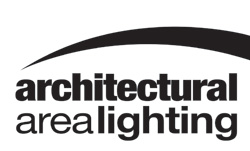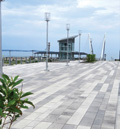This CE Center article is no longer eligible for receiving credits.
Landscape architects and designers consider a number of factors when designing for outdoor spaces. These factors include both the social and physical criteria that can influence the use and function of the space. The Project for Public Spaces (PPS) has been studying and evaluating public spaces since its founding in 1975. The PPS has found that there are four key qualities that make successful public spaces.
“They are accessible; people are engaged in activities there; the space is comfortable and has a good image; and finally, it is a sociable place: one where people meet each other and take people when they come to visit.” 1
In designing high-traffic outdoor spaces that are successful, architects, landscape architects, and designers should consider these four key qualities as outlined by the PPS: accessibility, aesthetic image, comfort, and sociability. Factors of safety, durability, and sustainability should also be considered.
Accessibility is achieved not only through location, visibility, and connectivity to and from other destinations but also through the selection of pavement surfaces that are safe for people of all ages and physical abilities. Compliance with the latest ADA (Americans with Disabilities Act) guidelines2 is essential to providing outdoor spaces that are safe and accessible by all users.
An outdoor space with an appealing aesthetic image will naturally entice more users into the space. Appealing outdoor spaces appear comfortable, clean, have adequate lighting and seating, and provide quality design through material selection. In addition, outdoor spaces that are designed for flexibility and are able to accommodate varied user groups as well as serve a variety of outdoor functions are thus more appealing and experience heavier use.
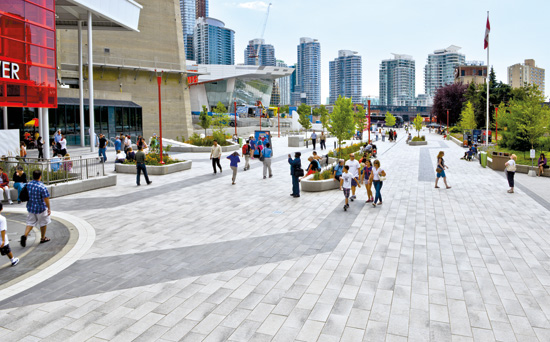
Photo courtesy of Unilock
Public Plaza at the CN Tower, Toronto, Ontario, designed by IBI Group LA / Graham Infrastructure LP, provides an accessible, comfortable, sociable outdoor public space.
Materials that are modular can provide opportunities for changing the structure and function of an outdoor space. Varied pavement materials or pavement patterns provide tools for differentiating sub areas within a larger outdoor space. The broad range of pavement choices provides options for both design aesthetics and function.
An outdoor space that is comfortable has adequate site amenities such as benches and site lighting. Site lighting provides security and comfort during night-time use and it can help to identify a public space, defining and highlighting various activity areas, entrances, and important features.
PPS states: “In many situations, particularly when people are concerned about security, there is a tendency to over-light a park, plaza, street, or other public space. But in fact, too much lighting can be just as bad as too little lighting. The key to developing a good plan is to relate lighting to the evening functions of a particular space, because in the larger view, street lighting is more than just a technical requirement, a security need, or a design element. It can be thought of and utilized in terms of how the type, placement, and wattage affect how a street is perceived and used.”3
Benches provide comfort for users needing a place to stop and rest, enjoy lunch, take in a conversation or just to relax. Benches should be placed based on how the space will be used, not just in regularly spaced intervals along a walkway or within the space. Providing the correct type of bench or seating is also important. Benches should provide seating in a variety of sunlight situations, accommodate wheelchair users on either side of the bench, and be ergonomically designed for user comfort. Ergonomic design standards indicate comfortable seat height of 18 inches, seat width of 12 to 18 inches for benches with backs, and 30 inches for benches without backs and a 95- to 105-degree angle for the seat back.

Photo courtesy of Tournesol Siteworks
Thermally modified wood benches provide comfortable seating in high-use areas.
Social outdoor spaces attract people and “what attracts people most, it would appear, is other people” (William H. Whyte: The Social Life of Small Urban Spaces).4 William H. Whyte observed this pattern of attraction in public outdoor spaces throughout the world. People were attracted to outdoor spaces that had social gatherings of other people. And an outdoor space that presents an image of safety will be more likely to attract people. Such spaces are easily accessible, have adequate lighting for safe night-time use, have adequate visibility and adequate seating, and provide safe walking surfaces.
Durability of materials is an important design criteria for high-traffic spaces. Non-durable materials will wear more rapidly and will create unsafe and unsightly elements in the space. Non-durable materials will also increase client costs as they will require increased maintenance and/or more frequent replacement.
Pavements for Accessibility and Sustainability in High-Traffic Areas
Of the many products available for pavement surfaces in high-traffic outdoor areas, modular pavers have seen increased popularity as they provide a wealth of design options with respect to color, size, and surface finish while being easy to install. Modular pavers provide flexibility for the design composition as well as ease of maintenance as individual units are easily removed and replaced should any unit become damaged through excessive abuse or severe impacts.
Studies have been done by the International Concrete Paving Institute (ICPI) regarding interlocking concrete pavers and ADA compliance.
Concrete Pavers
Interlocking precast concrete pavers provide many options with respect to size, shape, color, and surface texture. These pavers have been available to designers for many years and used in pedestrian, vehicular, and heavy-duty settings where durability is a requirement. The latest technologies and manufacturing processes take this durability to the next level in order to ensure the product maintains its texture and color without degradation in high-traffic areas. New processes have also given us products with surface textures and colors that look like natural stone as well as products that are unique and contemporary in styling and surface texture.
Pavers were originally manufactured with a mix of large and small aggregate throughout the entire unit that allowed for the large aggregate to become exposed at the surface over time.

Photo courtesy of Unilock
Central Ohio Transit Authority, Columbus, Ohio, used interlocking concrete pavers in a variety of colors for patterning.
Today, select manufacturers combine large and small aggregates in layers through the entire precast concrete paver mix with the larger aggregates in the base to provide strength and the smaller aggregates towards the top. A blended layer of the highest level performing minerals that are fade-resistant is embedded into the surface of each stone during the manufacturing process. This not only provides variable options for color and texture aesthetic but ensures that the surface will not fade, crack, peel, or delaminate, and offers a durable surface that maintains its color and character through years of high-traffic use.
When specifying precast concrete pavers, designers should consider the application and use—pedestrian, vehicular, or both. Other factors to consider in specifying interlocking precast concrete pavers include how the paver is made, the paver size or sizes, color, subsurface preparation, and the desired paver pattern. In addition, designers should determine whether the project must meet LEED®, SITES™, or IGCC (International Green Construction Code) criteria and if so, consider the selection of a color with a high solar reflectance index (SRI) value to reduce urban heat island effects and/or a permeable paver.
A number of interlocking precast concrete pavers are permeable and are available in a wide variety of styles and colors with ADA-compliant joint spacing thus helping to meet LEED®, SITES™, and IGCC criteria and assist in meeting local demands for sustainability. The Interlocking Concrete Paver Institute provides information relating to the permeability of interlocking precast concrete pavers.
ADA Design Guidelines require that surfaces be firm, stable, and slip resistant. The ADA Design Guidelines recommend that the static coefficient of friction for flat surfaces along accessible routes be 0.6 and 0.8 for ramps. ADA advisory material recommends various test methods to assess surface slip resistance. The Interlocking Concrete Pavement Institute's technical Specification Section 13 provides information on the slip and skid resistance of interlocking concrete pavements.5 When specifying precast concrete pavers, designers should note their capacity for slip resistance, resistance to salt erosion, and tolerance to resist oil and gas spills. These characteristics, along with their colorfast pigments and durable aggregate composition, can provide a surface material that is able to withstand high traffic as well as severe weather conditions.
To meet durability criteria, pavers are manufactured to comply with both ASTM C936 and CSA (Canadian) A 231.2 industry quality standards for strength and absorption as well as dimensional tolerances. During the manufacturing process, pavers are carefully tested, and hourly product density tests are performed. The high strength of concrete pavers, combined with low water absorption, provides a hardscape material that won't crack, peel, or delaminate. Interlocking precast concrete pavers can offer up to four times the strength of poured concrete.
High-quality pavers are manufactured with the highest-quality minerals and pigments that are color stable and do not fade. Interlocking precast concrete pavers can be made in custom colors and textures as well as with custom recycled content. At the United Nations Center in New York, the old window pane glass was ground and made into a pozzolan that was added to the concrete pavers during the manufacturing process as part of the recycled content of the paving stones.
Case studies have been done on the durability and quality of interlocking precast concrete pavers involving applications at high-traffic areas in Cleveland, Ohio. The Uptown Alleyway project was designed by James Corner Field Operation. The project covers approximately 65,000 square feet of both vehicular and pedestrian areas. Of the total area, approximately 35,000 square feet is permeable. This is the City of Cleveland's first permeable public roadway project. The alleyway uses long plank pavers in a variety of grey color tones. Due to the heavy pedestrian and vehicular traffic, it was essential that the paver surface be durable, color-fast, highly abrasion resistant, and strong to withstand the harsh winter climate.
The aesthetic appeal of interlocking precast concrete pavers lies in the variety of available colors and textures. While some options mimic natural stone, bricks, or cobbles, others offer contemporary surfaces, shapes, and sizing. It is this variety that allows the landscape architect or designer to execute their creative vision for the project, or to follow industry trends such as long, linear plank designs or large-format slab paving. From roof decks to streetscapes, permeable to heavy-duty, there is a paver for every application.
While color is always evolving, other trends include mixing different paver shapes within the paver pattern and varying textures for aesthetic appeal.

Photo courtesy of Unilock
The Grand Traverse Fire Station, Grand Traverse, Michigan, designed by Gourdie-Fraser, Inc., shows color options for permeable interlocking concrete pavers.
Flexible Concrete Mats
Flexible concrete mats can provide vehicular parking for high-traffic outdoor areas. The flexible concrete mats provide designers with the option to green up an outdoor space by adding vegetation to the interior openings in the mat. The mats are made of wet-cast, low-moisture-absorption concrete, which is cast with holes to allow for infiltration and root penetration of the infill vegetation material. Cast inside the concrete is an engineered polymer grid that provides flexibility to the concrete mat. This flexibility provides added tensile strength to complement the compressive strength of the concrete. The flexibility also allows these mats to conform to irregular ground surfaces along pre-defined linear grooves while providing structural support for high-traffic use. The flexible concrete mat maintains its load-supporting characteristics even when saturated. The design also eliminates sharp edges and won't crack and break like rigid concrete or pop up like plastic. The small openings in the concrete grid provide spaces for infill planting of turf grass or groundcovers as well as infill with gravel, sand, or crushed stone.
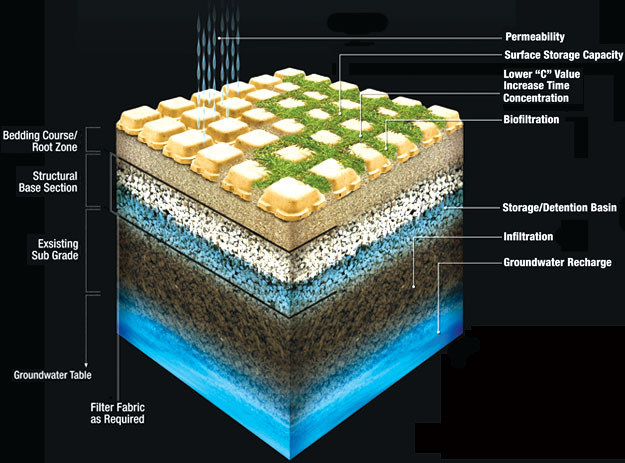
Photo courtesy of Soil Retention
This image shows the porous composition of a flexible concrete mat.
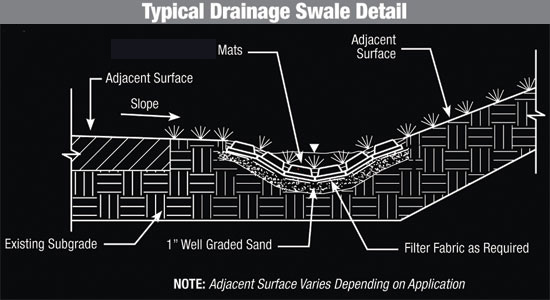
The mat is designed so that the grass or groundcover that is planted in the holes can develop a continuous root system below the mat surface, thus promoting a healthy turf while minimizing moisture evaporation. Because the flexible concrete mat has porous openings and a shallow depth, it allows water to flow through laterally and to penetrate the root system of the grass. In addition, the geometry of the mat limits infill and root compaction by concentrating the load on the concrete pads instead of void spaces. The large bearing connections of the concrete coupled with the size of the holes or void spaces provide the optimal situation for sustaining and maintaining grass or other groundcover materials.
Many urban sites with large paved surfaces are challenged in trying to obtain LEED® and SITES credits. LEED® NC Criteria SSc6.2 provides credits for Stormwater Design – Quality Control. Credits are given to projects that address polluted runoff. The credit measures the Total Suspended Solids (TSS) as the indicator of level of pollution and the design must be able to show that the stormwater treatment system is effective at treating all rainstorms for any year up to 90 percent of the average annual rainfall. The American Society of Landscape Architects in conjunction with the National Arboretum and the Lady Bird Johnson Wildflower Center has issued their Sustainable SITES Initiative rating system. Section 3 – Site Design Water provides a possible 23 credits for designs that manage and reduce stormwater at the site.
For high-traffic areas that must meet the requirements of LEED®, SITES™, or International Green Construction Code (IGCC) criteria, the flexible concrete mat can assist in stormwater management, reduce heat island effect, lower run-off coefficients, assist in on-site water storage and biofiltration, and contribute to groundwater recharge.
The mats can be used in place of concrete or asphalt pavement, thus providing alternative solutions to stormwater management by providing surface areas for biofiltration, infiltration, and water storage below the parking/driving surface without requiring the loss of valuable site area to surface bioswales or detention basins. An example of this type of use is the fire lane at a Kaiser Permanente Hospital. The total surface area of flexible concrete mats can contribute towards required green space allowances and also meet criteria for reducing Heat Island Effect.
A project in Hastings on Hudson, New York, features three different residences on a shared lot just across from a walking trail. An area was needed for off-street parking for up to seven vehicles. The Planning Board wanted to be assured that whatever was used to create the unique, diagonally shaped parking space would blend well with the natural surroundings and not distract from the nearby Aqueduct Trailway. Ned Baldwin, senior partner with the firm of Baldwin & Franklin Architects, proposed the use of flexible concrete mats to create an area of drivable grass. “By using drivable grass instead of asphalt paving, we easily gained the approval of the Planning Board,” says Baldwin. “The grass we planted over it turned green in less than three weeks, which was very encouraging, but the winter was the most severe we've had in 15 years with as much as 30 inches of snowfall at one time. Despite that terrible winter so soon after its installation, it continues to thrive.”
Flexible concrete mats are manufactured to meet ASTM precast concrete standards for compressive strength, standard proctor, particle size analysis, concrete aggregates, mixed concrete, Portland cement, blended hydraulic cement, slump flow and pigments for integrally colored concrete. The manufacture process for the flexible concrete mats also follows the American Concrete Institute (ACI) standard practice for selecting proportions for normal, heavy weight, and mass concrete, and for durability.
Flexible concrete mats can be used in all climate areas, but specific recommendations are provided for cold weather applications. Specifications recommend that sites requiring the use of snowplow machinery install mow curb strips prior to installation of the paving mats and that the mats should be depressed ½ inch below the top of the mow curb/strip to protect the mat from the snowplow blade. In addition, it is recommended that snowplow equipment operators be educated about the underlying surface prior to snow removal and that the snowplow equipment be fitted with Teflon runners to prevent damage to the mat.
Durable Wood Walking Surfaces
Modular wood tiles can provide another option for high-traffic areas which require durable and sustainable walking surfaces. Because of their modular characteristic and design flexibility, modular wood tiles can be installed over a variety of surfaces and are adaptable to a variety of sites. Modular wood tiles can be used to create large wood deck surfaces either on building rooftops or at ground-level surfaces. At the ground level, these modular decks have served as outdoor dining areas for high-traffic restaurants and as pop-up parks.
Pop-up parks or parklets have been designed and built throughout the United States in areas of varying climate such as New York, California, Minnesota, and Colorado. Modular wood tiles were used in the first-ever pop-up park in the country at the Mojo Café in San Francisco, California. The pop-up park has been in use since 2010 and repurposed street space for people rather than cars. The parklet, which takes up space formally occupied by two parked vehicles, provides several hundred square feet of benches, tables, planters, and bike racks. The pilot program in San Francisco was a huge success and increased sales at a local café by 20 percent. As a result, additional employees were hired. The success of this program led the way for dozens of similar projects across the city, making livable streets possible all over the United States.
Studies have been done to evaluate the function and durability of pop-up parks using modular wood tiles. The studies show an emerging trend among communities throughout the country with a desire to make use of small urban spaces that are traditionally unbuildable. Modular wood tiles enable greater design creativity in small urban spaces.
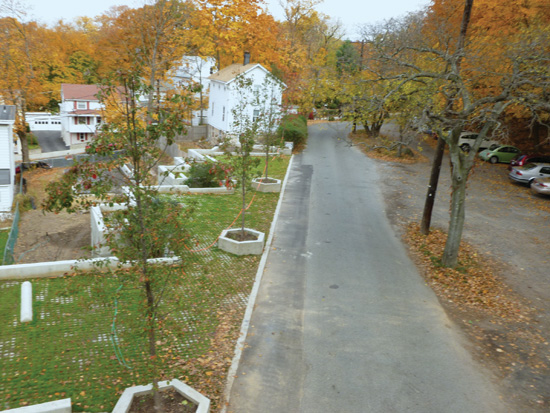
Photo courtesy of Soil Retention
The use of flexible concrete mats creates a drivable grass area in Hastings on Hudson, New York.
Modular wood deck tiles are FSC® certified (FSC-C13454) so Ipe and Massarunduba wood tiles could contribute LEED points under Materials and Resources Credit 7 (MR Credit 6 for CS). The wood tiles are supported by pedestals, which contain 20 percent post-industrial recycled material, thus potentially contributing to multiple points within Materials and Resources Credits 4 as a single product contributing to multiple LEED points. The tiles are made from wood remnants. These remnants are premium-grade shorts purchased from the flooring and furniture industries that comply with strict regulations regarding extraction, milling, and transport.
Modular wood tiles come in 2 foot by 2 foot (2 x 2) and 2 foot by 4 foot (2 x 4) sized units. Each modular tile has seven to eight top slats and three bottom slats that are held together with 48 stainless steel screws that are inserted from the bottom so that the fasteners are not visible on the surface. The wood tiles are integrated with a pedestal system with tabs which hold the wood tile units in place. A fastening kit adds further stability with the system. The pedestal system has a levelling capacity that compensates for slope and changes in grade. Through this levelling system, elevations can be adjusted from heights as little as 1/8 of an inch up to 36 inches with pedestal attachments.
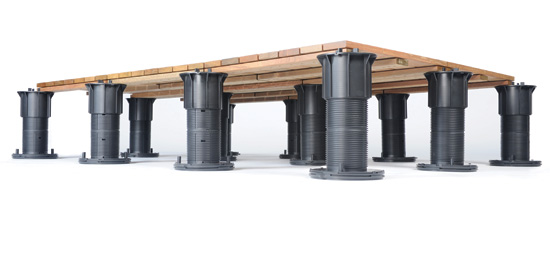
Photo courtesy of Bison Innovative Products
Modular wood tiles supported by HDP pedestals
The wood tiles are ADA compliant as the surface texture and spacing between the units meet ADA criteria. The wood tiles meet industry standards and certifications for wind uplift, fire rating, slip resistance, weight-bearing capacity, and seismic. To ensure adequate weight bearing in support of heavier loads, it is recommended that more pedestals be used above the standard 1.2 ratio of pedestals to wood tiles. With respect to seismic and uplift requirements, the pedestal systems can include stabilizing bracing in addition to fasteners which deter wind uplift.
Site Amenities for High-Traffic Outdoor Spaces
Site amenities that enhance comfort and safety will make an outdoor space much more inviting. In high-traffic areas, site amenities such as benches, planters, and site lighting should be durable to minimize maintenance and energy efficient to lower operation costs. Sustainability criteria and certifications are a way of ensuring a successful, cost-effective project.
Lighting plays a major role in visual comfort and security. Architectural flood lighting, pedestrian-scale decorative lighting, and in-grade luminaires for targeted up-lighting enhance and accent the beauty of the architecture and site features.
Benches provide comfort and enhance the image of outdoor spaces. According to the Project for Public Spaces, users are drawn to outdoor areas that present a positive image and provide comfortable elements such as benches. Benches can be fabricated from a variety of materials including cast iron, aluminum, composite wood, recycled plastic, concrete, and natural wood. Each material has benefits and can be used appropriately in high-traffic outdoor spaces.
Lighting for Parking and Larger Outdoor Areas
The International Dark Sky Association (www.darksky.org) has completed research on LED lighting. LED lighting is much more efficient than conventional incandescent lighting at converting electrical energy to light. In conjunction with newer luminaire designs, LED lamps provide reduced energy use without compromising safety. Through this reduced energy demand/use, LEDs lower carbon emissions and also lower costs to the user/consumer. Use of LED technology for lighting can contribute qualification points to LEED® and SITES™ rating systems. A possible 16 total credits can be earned toward LEED certification in the use of LED lighting.
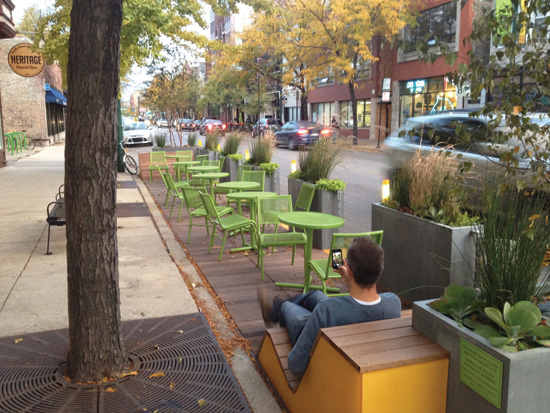
Photo courtesy of Bison Innovative Products
A pop-up park in Chicago using modular wood tiles
For larger outdoor spaces and parking areas, architectural LED flood lights with targeted optics provide safe levels of lighting for high-traffic areas while allowing the designer control over excessive or trespass lighting outside of the application areas through the use of targeted optics.
For targeted optics, LED modules are recessed into the fixture housing to provide a glare-free zone with zero upright. The independent LED modules function as multiple points of an omni-directional optical system arranged to create the most optimum light distribution. Each luminaire has adjustable emitter modules to provide maximum spacing with uniform horizontal and vertical illumination. These modules are capable of a 70-degree vertical tilt and 350-degree rotation without ever moving the luminaire housing.
The International Dark Sky Association evaluates the zonal distributions and blue light content of LED luminaires and has established a Fixture Seal of Approval Program.6 Obtaining their seal of approval is dependent on the luminaire meeting one of many criteria including:
• Fixture must emit no light above 90 degrees (with the exclusion of incidental light reflecting from fixture housing, mounts, and pole).
• Fixture must have a listed correlated color temperature (CCT) configuration of 3,000K or below.
The luminaires comply with Dark Sky requirements for light trespass and light pollution and the structural LED optical system and flat lenses produce zero light above 90 degrees.
Incandescent and high-intensity discharge lamps can produce unnecessary light concentrations beneath the luminaire. The LED modules significantly reduce point source glare and smooth hot spots of other LED luminaires. Users experience the appropriate illuminance levels for uniform and quality lighting throughout the various needs of the application. Improving the light levels in the dark zones reduces shadowing and potential hazard areas, providing for a more secure design.
The LED modules in architectural LED flood lighting are designed with two distinct but complementary methods to manage the life-limiting heat produced by the LED diodes. Both conduction and convection are used and the optical system is monitored by circuitry tying back to the driver controls. Heat is drawn away from the housing chamber and dispersed into the air around the luminaire to maintain diode performance output and ensure longer life.
Dark Sky compliance through the International Dark Sky Association can be met through the use of cut-off fixtures, and the LED luminaires can also meet Illuminating Engineering Society (IES) TM15 requirements or “BUG” criteria. BUG stands for Backlight, Uplight, and Glare. The IES established the BUG criteria in 2005 as a result of increased demand for reduction in glare and light trespass. LEED SS 8.8 for exterior lighting credits are given if the site lighting used provides optimum down lighting (Dark Sky Friendly™) fixtures. Fixtures must be full cut-off for park/rural settings and for residential/commercial settings, have less than 2 percent uplight above 90 degrees.
LED light conversions were made in Boston, Massachusetts, when the city embarked on a major conversion of their light fixtures to more energy-efficient LED fixtures. Starting in 2012, Boston converted thousands of their existing 175W and 250W Mercury Vapour Acorn lights with replacement 60W and 75W LED lights. The City plans to change all existing Acorn lights with LED lights by the end of 2016. Boston's city-wide LED conversion has cut their energy consumption by 50 percent and payback is expected in 1.5 years.
The City of Austin, Texas holds a “south by southwest” (SXSW) event every year. This event sees high-traffic use, and LED lighting provided the necessary light levels to enhance the safety of the event. The poles supporting the LED lights also provided an aesthetic image appeal as the City hung 55 decorative pendants from them. This is a City of Austin pilot program which includes 12 new streetlights and the conversion of 48 streetlights on Sixth Street between Interstate 35 and Brazos Street. The lights will brighten after the bars close for the night to enhance nighttime safety and return to normal once crowds disperse. The light levels are controlled remotely.
In-Grade Flood Lighting Provides Safety and Ambiance
Architectural LED flood lights are also available as in-grade or in-ground fixtures. In-grade fixtures or luminaires can provide both safety and ambiance lighting in areas where pole-mounted flood lighting would not be appropriate. In-grade luminaires can be placed to provide uplighting of trees, flagpoles, and buildings, and the ambient light provides both aesthetic visual safety illumination.

Photo courtesy of Kim Lighting
In-grade flood lighting at Long Beach Convention Center, California
Aiming can be controlled in LED in-grade luminaires with a Bluetooth-enabled mobile device. The end user, designer, or property manager can select either an iOS or Android mobile device to change the optical orientation and dim or brighten the amount of light from the luminaire. To contribute to the sustainability of a project, the housings for LED in-grade luminaires can use durable brass castings and use lenses of thick tempered glass to protect against breakage, chipping, and scratches. IP68 type connections protect the interior of the light and prevent dues, moisture, and water intrusion.
The IP rating system is the Ingress Protection rating ( IP = Ingress Protection). These ratings are part of the International Electrical Code standards. The rating system classifies the degrees of protection provided again the intrusion of various elements. The first digit provides the intrusion rating against solids and the second digit provides the rating for intrusion against liquids. In-grade flood lights have been used by the communities of Long Beach, California and Fort Myers, Florida.
Pedestrian-Scale Decorative Lighting
Pedestrian-scale decorative lighting presents another option for lighting in high-traffic outdoor areas. These luminaires are available in a range of pole heights and luminaire sizes to provide options for various outdoor lighting applications.
Pedestrian-scale decorative lights can provide energy-efficient LED point source lights while providing reduced glare lighting through diffused lenses. A die-cast back housing with segmented, high-reflectance, aluminum mirrors provides a precision optical system to put light where it is needed, minimizing light trespass, sky glow, and other forms of light pollution. These optical systems are engineered for highly controlled and more effective light distribution. Because of their glare reduction and minimal light pollution, these lights are International Dark Sky compliant and meet the standards of the Design Light Consortium (DSL) of the U.S. Department of Energy.
Pedestrian-scale decorative luminaires are produced with sustainable technologies that have as small an impact on the environment as possible. Renewable materials such as aluminum and glass are used.
Light poles do not need to be fabricated of metal or fiberglass. Spun concrete poles can provide durable, cost-effective lighting for outdoor areas. Concrete poles are fabricated of 8,000 psi concrete so they are four times the strength of a sidewalk and will last over 75 years. Concrete light poles are durable, maintenance free, do not rust, and can take considerable impact. Concrete poles also retain their color, and the color is not applied to the surface but is embedded through the entire depth of the pole as part of the fabrication process.
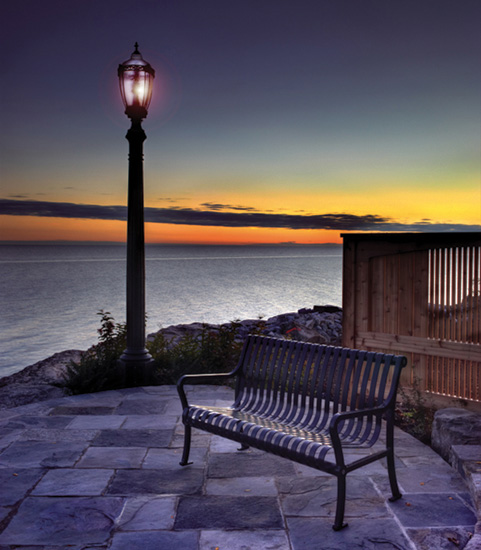
Photo courtesy of the StressCrete Group
Spun concrete poles combine elegance with durability in outdoor spaces.
Spun concrete poles are a centrifugally cast reinforced concrete. They are commonly referred to as a “spun concrete pole” as they have the compressive strength of concrete but contain strand cables around which the concrete is spun. This cabling provides the tensile strength to the pole. The poles meet ASTM and CSA standards for spun concrete poles. The spinning process introduces qualities into the concrete which cannot be obtained by more conventional casting methods. Through the spinning process, the concrete attains a higher density and strength. The spinning process allows a hollow raceway to form inside the pole, thereby providing a smooth conduit for electrical cables.
Poles of spun concrete have a long service life, require minimal maintenance, have minimal vibration and deflection qualities, and are easily installed because they can be directly embedded to the site via a baseplate mounting system. This direct embedment eliminates the need for a footing and makes the spun concrete poles cost effective. The concrete poles also meet ASTM and AASHTO wind loading requirements and have a lifetime warranty.
Spun concrete poles also provide some safety advantages. Electrical fires cause power failures because of salt corrosion on poles. Concrete poles do not require any further fire protection because concrete is a non-combustible material. With Concrete poles, the structural integrity remains intact safeguarding people from power failures.
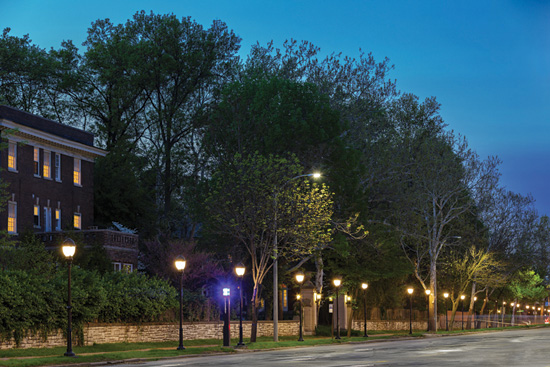
Photo courtesy of Architectural Area Lighting
Decorative pedestrian-scale lighting, Skinker Boulevard, St. Louis, Missouri
Spun concrete poles can also contribute to LEED® certification points as concrete is comprised of naturally sourced materials of water, sand and aggregated. Concrete poles are 100 percent reusable at both the existing site and for new site applications. The extremely long life span (75+ years) means that they can be reused to mount new upgraded lighting fixtures for future site upgrades and expansions. This minimizes energy and materials costs. Therefore, concrete poles can potentially offer up to 2 credits to LEED MR 1.3. Spun concrete poles contain Portland cement, which has a very good reflectance ratio (approx .35) and they can be made of a light colored concrete. This leads to a reduction in Heat Island affect for the site and can contribute to LEED Site Credit 7 Heat Island reduction. Other possible LEED credits may be obtained for MR 4.1, 4.2 for the recycled content of the poles and MR 5.0 for use of locally sourced materials.
Benches for Comfort and Image Appeal
The best outdoor spaces have site amenities that make them both comfortable and appealing to users. Appropriately placed benches provide rest stops for users and can affect how people use a space based on their location. Design and material selection are other factors to consider in the selection of benches. There are a wealth of available materials for bench fabrication which include stone, concrete, wood, metal, recycled plastic. Material selection should be based on site location and projected use as well as availability of bench materials. Benches fabricated from recycled or locally sourced materials will assist in gaining LEED credits for a project.
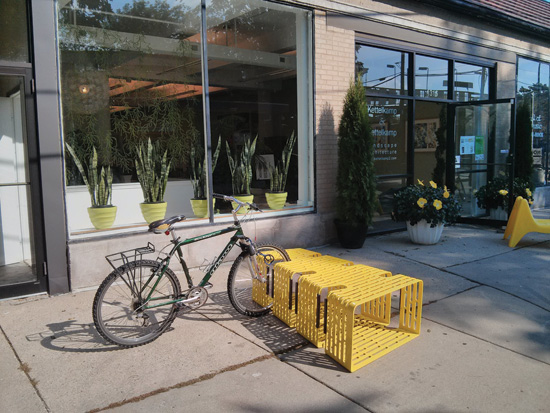
Photo courtesy of Tournesol Siteworks
A multipurpose bench used in Brisbane, Australia
Thermally Modified Wood
Natural wood products can be very durable in high-traffic outdoor areas and they provide a strong appeal for users because of the material's warmth and natural feel. Thermally modified wood provides a more durable product than traditional cedar or teak benches and they are sustainable because the wood that is used is locally derived domestic Forest Stewardship Council (FSC) certified wood. Thermally modified wood benches also provide long-term dimensional stability and rot resistance without chemicals. Thermally modified wood benches utilize wood planks for backs and seating with either cast aluminum or cast iron frames.
Modular Concrete
Concrete provides an alternative option for benches. Concrete can be molded into varied shapes and forms providing designers with greater variety in composition of site elements and thus adding image appeal to outdoor spaces. Modular concrete benches provide a highly configurable modular seating system which promotes social interaction. Concrete is also a very durable material for high-traffic areas.
Skyline Tower is a 24-story office tower located in Bellevue, Washington's central business district with direct access to the highly traffic transit system. The Skyline Tower provides impressive views of the Seattle skyline, Mt. Rainier, and the Olympic Mountains. It also offers a pedestrian friendly exterior plaza with modular concrete benches as a defining design element.
Multipurpose Benches
Not all high-traffic areas are large open spaces. Many high-traffic public areas are busy streets or streets that have been transformed into pedestrian plazas or in some cases “complete streets”7 with an interface of pedestrians, vehicular traffic, and bicycle traffic. Multipurpose benches can provide a site amenity that serves both pedestrians and bicyclists and also assists in saving space for those narrow, small outdoor areas. Multipurpose benches provide both seating and a bicycle rack.
These multipurpose benches can be fabricated from a variety of durable materials. Some are all metal, some of combined metal frame and high-density plastic, some of combined metal frame and wood. The bicycle rack components are integrated into the rear or side of a traditional bench or in some cases integrated within a rectangular backless bench framework.
In addition to providing a site amenity that serves the “social” element of public outdoor spaces, these multipurpose benches also can serve as space dividers in large outdoor areas.
Planters for Curb Appeal
Commercial heavy-duty planters can help to delineate outdoor areas, add options for greening an areas, and contribute to image and curb appeal making the space more inviting to users.
Planters for high-traffic areas are available in heavy duty glass fiber reinforced concrete. The glass reinforcing prevents the planter from deforming under the weight of the soil. The planters are, however, lighter in weight than traditional concrete planters so they are less costly to ship and easier to maneuver around the space.
Benches, bike racks, and planters contribute to the overall image appeal of an outdoor area, providing comfort and amenities that will entice users to take a break. These elements can also help to define smaller spaces within a larger outdoor area.
Conclusion
There are many emerging trends resulting from the increased traffic and use of outdoor public spaces. Changes in ADA (Americans with Disabilities Act) compliance requirements and the advent of new sustainability criteria have required designers to use newer products that are durable, sustainable, meet ADA criteria and provide both safe and aesthetically pleasing elements within highly used outdoor spaces.
Designers are seeing emerging product trends in:
• Shifting colors of LED lighting to reduce the “blue light” color tones
• Adaptive control systems with lighting to allow users to better control and regulate the direction of the light and the amount of energy used.
• Modular site amenities and pavement products to provide more flexibility and creativity with outdoor space design.
• A greater variety of materials being used in the fabrication of light poles, benches, bike racks, planters and pavement products.
• A greater number of sustainable, locally derived and eco-friendly products
Designing for high-traffic outdoor spaces presents many opportunities to utilize new products and emerging product trends in creating outdoor spaces that meet the four key qualities of accessibility, aesthetic image appeal, comfort and sociability.
Endnotes
- http://www.pps.org/reference/grplacefeat/
- http://www.ada.gov/2010ADAstandards_index.htm
- http://www.pps.org/reference/streetlights/
- Whyte, Wm. H., The Social Life of Small Urban Spaces, 1980, Edwards Brothers, Inc., Ann Arbor, Michigan
- ICPI Tech Spec 13 – Slip and Skid Resistance of Interlocking Concrete Pavements, http://www.icpi.org/node/3830
- http://www.darksky.org/ida-fixture-seal-of-approval/about-fsa
- www.smartgrowthamerica.org/complete-streets/complete-streets-fundamentals/complete-streets-faq
Elena M. Pascarella, PLA, ASLA, is the principal of Landscape Elements LLC,an award-winning landscape architectural firm based in Warwick, Rhode Island. Ms. Pascarella is a graduate of the Rhode Island School of Design and has done graduate studies in historic landscape preservation at the University of Virginia. Landscape Elements LLC provides landscape architectural design and planning services in CT, RI and MA. Ms. Pascarella has written a number of articles for Architectural Record that have addressed sustainability (Grey to Green Infrastructure, November 2012) and urban trees (Trees Need Dirt, December 2014).














